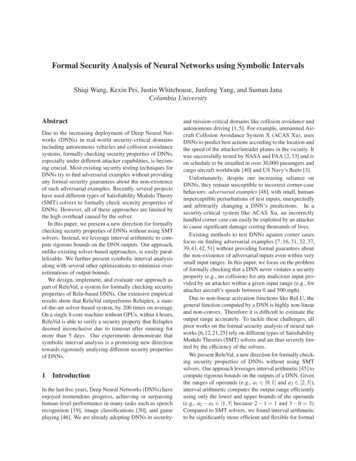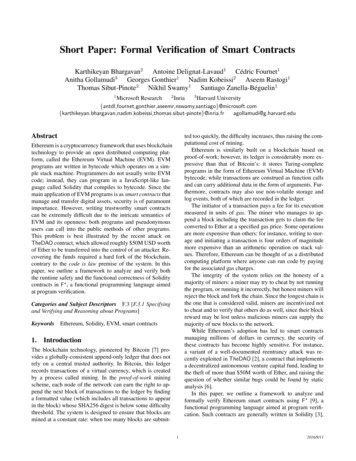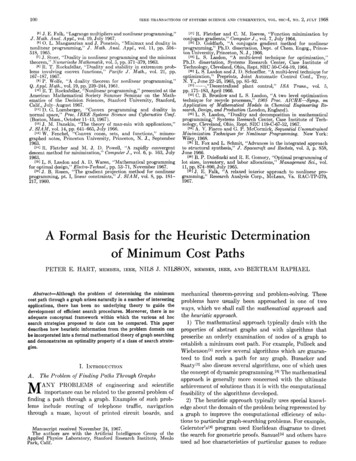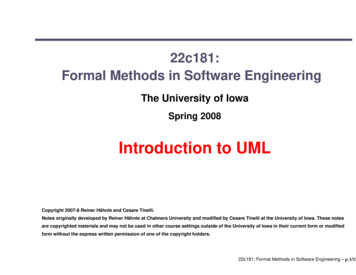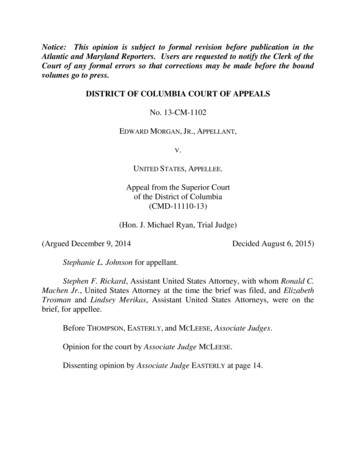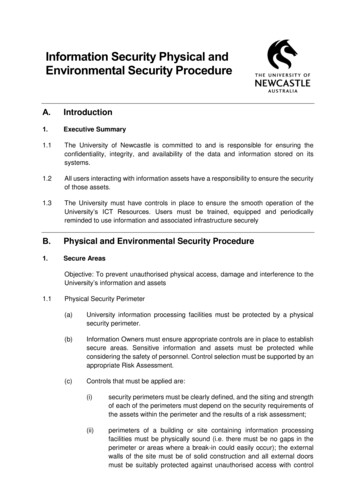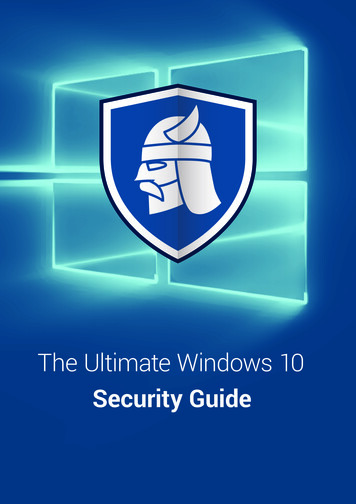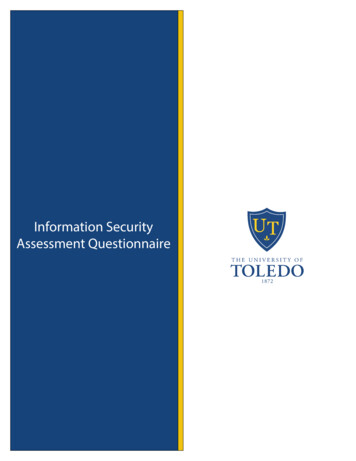
Transcription
A Formal Security Analysis of the Signal Messaging ProtocolExtended Version, July 2019†Katriel Cohn-Gordon , Cas Cremers† , Benjamin Dowling‡ , Luke Garratt§ , Douglas Stebila¶ Independent Scholar† CISPA Helmholtz Center for Information Security, Germany‡ ETH Zürich, Switzerland§ Cisco Systems, USA¶ University of Waterloo, waterloo.caAbstractThe Signal protocol is a cryptographic messaging protocol that provides end-to-end encryption forinstant messaging in WhatsApp, Wire, and Facebook Messenger among many others, serving well over1 billion active users. Signal includes several uncommon security properties (such as “future secrecy” or“post-compromise security”), enabled by a novel technique called ratcheting in which session keys areupdated with every message sent.We conduct a formal security analysis of Signal’s initial extended triple Diffie-Hellman (X3DH) keyagreement and Double Ratchet protocols as a multi-stage authenticated key exchange protocol. We extractfrom the implementation a formal description of the abstract protocol, and define a security model whichcan capture the “ratcheting” key update structure as a multi-stage model where there can be a “tree”of stages, rather than just a sequence. We then prove the security of Signal’s key exchange core in ourmodel, demonstrating several standard security properties. We have found no major flaws in the design,and hope that our presentation and results can serve as a foundation for other analyses of this widelyadopted protocol.1. IntroductionRevelations about mass surveillance of communications have made consumers more privacy-aware. Inresponse, scientists and developers have proposed techniques which can provide security for end users even ifthey do not fully trust the service providers. For example, the popular messaging service WhatsApp was unableto comply with Brazilian government demands for users’ plaintext messages [16] because of its end-to-endencryption.Early instant messaging systems did not provide much security. While some systems did encrypt trafficbetween the user and the service provider, the service provider retained the ability to read the plaintext of users’messages. Off-the-Record Messaging [17, 30] was one of the first security protocols for instant messaging:acting as a plugin to a variety of instant messaging applications, users could authenticate each other using publickeys or a shared secret passphrase, and obtain end-to-end confidentiality and integrity. One novel feature ofOTR was its fine-grained key freshness: along with each message round trip, users established a fresh ephemeralDiffie–Hellman (DH) shared secret. Since it was not possible to work backward from a later state to an earlierstate and decrypt past messages, this technique became known as ratcheting; in particular, asymmetric ratchetingsince it involves asymmetric (public key) cryptography. OTR saw relatively limited adoption, but its ratchetingtechnique can be seen in modern security protocols.Perhaps the first secure instant message protocol to achieve widespread adoption was Apple’s iMessage,a proprietary protocol that provides end-to-end encryption. A notable characteristic of iMessage is that itautomatically manages the distribution of users’ long-term keys, and in particular (as of this writing) users haveno interface for verifying friends’ keys. iMessage, unfortunately, had a variety of flaws that seriously undermineits security [38].The Signal Protocol. While there has been a range of activity in end-to-end encryption for instant messaging[33, 71], the most prominent development in this space has been the Signal messaging protocol, “a ratchetingforward secrecy protocol that works in synchronous and asynchronous messaging environments” [55, 56].Signal’s goals include end-to-end encryption as well as advanced security properties such as perfect forwardsecrecy and “future secrecy”.The Signal protocol can be roughly divided into three types of stages: The initial key exchange, or X3DH (extended triple Diffie-Hellman) protocol [64], which combineslong-term, medium-term and ephemeral Diffie-Hellman keys to produce a shared secret “root” value.† An overview of changes can be found in Appendix D. An extended abstract of this paper appears at IEEE EuroS&P 2017.D.S. was supported in part by Australian Research Council (ARC) Discovery Project grant DP130104304, Natural Sciences and EngineeringResearch Council of Canada (NSERC) Discovery grant RGPIN-2016-05146 and Discovery Accelerator Supplement RGPAS 492986-2016.
An asymmetric ratchet stage [63], where users alternate in sending new ephemeral Diffie-Hellman keys ina ping-pong fashion with previously generated root keys to generate forward-secret chaining keys. A symmetric ratchet stage [63], where users take no additional entropy but instead use key derivationfunctions to ratchet forward chaining keys to create symmetric encryption keys.Each message sent by a user is encrypted using a fresh message key, which attempts to provide a high degreeof forward secrecy. The ping-pong pattern of new ephemeral Diffie-Hellman keys inject additionally entropyinto this process, which is intended to continually achieve perfect forward secrecy as well as post-compromisesecurity. The Signal protocol, and in particular its ratcheting construction, has a relatively complex history. TextSecure[56] was a secure messaging app and the predecessor to Signal. It contained the first definition of Signal’s“Double Ratchet”, which effectively combines ideas from OTR’s asymmetric ratchet and a symmetric ratchet(which applies a symmetric key derivation function to create a new key, but does not incorporate fresh DHmaterial, similar to so-called “forward-secure” symmetric encryption [11]). TextSecure’s combined ratchet wasreferred to as the “Axolotl Ratchet”, though the name Axolotl was used by some to refer to the entire protocol.TextSecure was later merged with RedPhone, a secure telephony app, and was renamed Signal1 , the name ofboth the instant messaging app and the cryptographic protocol. In the rest of this paper, we will be discussingthe cryptographic protocol only.The Signal cryptographic protocol has seen explosive uptake of encryption in personal communications: it (or avariant) is now used by WhatsApp [73], Wire [39], and Facebook Messenger [34], as well as a host of variantsin “secure messaging” apps, including Silent Circle [58], Pond [53], and (via the OMEMO extension [70] toXMPP) Conversations [25] and ChatSecure [4].Security of Signal. One might have expected this widespread uptake of the Signal protocol to be accompaniedby an in-depth security analysis and examination of the design rationale, in order to: (i) understand and specifythe security assurances which Signal is intended to provide; and (ii) verify that it provides them. However, thiswas not the case when it was released: when WhatsApp’s Signal Protocol integration was announced in 2015,there was little Signal Protocol documentation available and no in-depth security analysis. This was in starkcontrast to the ongoing development of the next version of the Transport Layer Security protocol, TLS 1.3,which explicitly involved academic analysis in its development [14, 27, 31, 44, 48, 54].Since then, documentation has been introduced for both the X3DH initial key exchange protocol [64], aswell as the Double Ratchet protocol [63], covering both the asymmetric and symmetric ratcheting stages of theSignal protocol.Frosch et al. [36, 37] had performed a security analysis of TextSecure v3, showing that in their modelthe computation of the long-term symmetric key which seeds the ratchet is a secure one-round key exchangeprotocol, and that the key derivation function and authenticated encryption scheme used in TextSecure aresecure. However, it did not cover any of the security properties of the ratcheting mechanisms.In addition, Frosch et al. identified an Unknown Key Share (UKS) attack against TextSecure, because thecryptographic material was not bound to the identities. Since UKS attacks can be subtle, we explain the attackslightly differently, using the agent names as in [36, Section 4.2] to simplify comparison.Unknown Key Share (UKS) attacks. In this work, we use the original definition of UKS attack as definedin 1999 in [15]2 . In a UKS attack, the target of the attack is a session of an honest agent (e.g., Pe ) that triesto communicate with another honest agent (e.g., Pa ). Furthermore, in a UKS attack, the adversary does notlearn the session key: instead, the point is the mismatching peer assumptions of the honest agents. In a protocolsecure against UKS attacks, if two honest agents end up sharing a key, each should be the intended peer of theother. In a UKS attack, this assumption is violated. Depending on the UI and implementation details, this is asubstantial authentication failure. Concretely, receiving and successfully decrypting a message in a protocolvulnerable to UKS attacks does not guarantee that the message was intended for the recipient. (If Ed receives amessage “you’re fired” from his boss Alice, he cannot deduce that Alice intended to fire him.)The UKS attack on TextSecure v3. In the UKS attack from [36, Figure 7], the adversary is Pb who aims toattack Pe . When Pa tries to communicate with Pb as its peer, Pb lies about its public identity key and presentsPe ’s key as its own. Note that Pe is the target of the attack (not Pa , who is communicating with a dishonestagent). The adversary subsequently reroutes Pa ’s messages to Pe , who is the real target of the attack. Ultimately,Pa and Pe compute the same keys. Pe assumes that the keys are shared with Pa , which is correct. However,Pa thinks they are shared with Pb . Concretely, Pe may now falsely assume that when it receives messages1. TextSecure v1 was based on OTR; in v2 it migrated to the Axolotl Ratchet and in v3 made some changes to the cryptographicprimitives and the wire protocol. Signal is based on TextSecure v3.2. We note that the X3DH documentation [64, p. 4.8] gives a very different interpretation of UKS attack, which is not compatible withthe original definition from [15]. The X3DH documentation instead describes a UKS attack as an “identity misbinding attack” that involvespresenting someone else’s public key as one’s own. While a (traditional) UKS attack can easily be prevented by a simple modification ofthe key exchange protocol, the identity misbinding phenomenon cannot.2
encrypted with such a key, then they are intended for Pe . In fact, Pa intended them for Pb . This constitutes aUKS attack.Preventing UKS attacks. The fix for UKS attacks can be trivial for libraries with access to agent identities:including both agents’ identities in the key derivation function stops the attack. However, this UKS attack isnot prevented by the Signal core (i.e., the key agreement and Double Ratchet analysed here), because derivedkeys still do not depend on the identities of the communication partners. The UKS attack can also be preventedat the application level, for example by including the assumed peer identities (e.g., the peer’s phone number) ininitial message exchanges.Providing a security analysis for the Signal protocol is challenging. First, Signal employs a novel and previouslyunstudied design, involving over ten different types of keys and a complex update process which leads tovarious “chains” of related keys. It therefore does not directly fit into traditional analysis models. Second, someof its claimed properties have only been formalised relatively recently [24].1.1. ContributionsWe provide an in-depth formal security analysis of the key establishment core of the Signal messagingprotocol, which is used by more than a billion users.Our paper focuses on the multi-stage AKE protocol aspect of Signal. Our formalism in Section 4 defineswhat a multi-stage AKE protocol is and a generic security experiment for multi-stage AKE protocols capturingsession-key indistinguishability, then provides specialized freshness conditions that capture specific propertiesof Signal.Compared to previous multi-stage AKE security models which involve a single sequence of stages withineach session, our model allows for a tree of stages which model the various “chains” in Signal.Our model remains generic for multi-stage AKE protocol as it is parameterized by freshness and cleannessconditions that allow the model to capture different security properties of session key indistinguishability. Weproceed to provide cleanness conditions that are specialized to capture specific properties of Signal correspondingto its unique security goals. Among the interesting aspects of our model are the subtle differences betweensecurity properties of keys derived via symmetric and asymmetric ratcheting. In particular, the relationshipbetween the initial key exchange and the subsequent ratcheting stages is partly why we chose to captureboth the initial key exchange and the subsequent protocol in a single model. In addition, there is no cleardelineation within Signal between these two protocols, as some secret values generated during the initial X3DHkey exchange are re-used within the subsequent Double Ratchet protocol.We subsequently prove that the key establishment core of Signal is secure in our model, providing the firstformal security guarantees for Signal.We give a proof sketch in Section 5 and the full proof in Section B.3. At a high level, the proof techniqueis relatively straightforward and conventional. We suppose that there exists an adversary which breaks Signal,and construct an adversary which breaks a primitive. To do so, we perform a series of game hops, followedby a case distinction on the type of attack the adversary performs. Specifically, we split our analysis intofive general cases, each corresponding to a “stage” that derives a message key, be they the initial X3DH keyexchange, an asymmetric ratcheting stage, or a symmetric ratcheting stage. Within these stages, we split ouranalysis further into subcases, each corresponding to a pair of Diffie-Hellman keyshares that the attacker has notaccessed the associated secret value of. After some more game hops, we arrive at a game which is unwinnableby construction. Combining the intermediate probability bounds leads us to our overall security theorem.Signal does not cleanly separate key exchange from subsequent data messages, and so we had to rearrangethe order of certain operations in order to make this separation. It also re-uses Diffie–Hellman keys for signatures;we did not model this reuse. The details of these changes are described later.Our full proof is in the random oracle model, but we have also outlined the steps required for a proof inthe standard model as a delta to the original proof, using (a variant of) the PRF-ODH assumption. As our proofis essentially a case distinction, the latter addition is not only arguably using a more plausible cryptographicassumption, but also provides more concrete analysis of the different security guarantees depending on how amessage key is derived in the Signal Protocol.In practice, Signal is more than just its key exchange protocol. In Section 6, we describe many other aspectsof Signal that are not covered by our analysis, which we believe are a rich opportunity for future research. Wehope our presentation of the protocol in Section 2 can serve as a starting point for understanding Signal’s core.1.2. Additional Related WorkA moderate body of research has arisen around the Signal Protocol, of which we give a brief summary.In concurrent work to the conference version of this paper, Kobeissi, Bhargavan, and Blanchet [46] use ProVerifand CryptoVerif to analyze a simplified variant of Signal specified in a JavaScript variant called ProScript.Their main focus is to present a methodology for automated verification for secure messaging protocols and3
their implementations, and they consider a variant of Signal (that, e.g., does not use symmetric ratcheting).They identify a possible key compromise impersonation (KCI) attack; we discuss this further in the context ofour model in our discussion of freshness in Section 4.3. From the ProScript code, they automatically extractProVerif models that consider a finite number of sessions without loops. The CryptoVerif models are createdmanually. In both cases, the analysis involves the systematic manual exploration of several combinations ofcompromised keys. In contrast, we set out to manually construct and prove the strongest possible property thatholds for Signal. For the core protocol design, this allows us to prove a stronger and more-fine grained securityproperty.Related techniques. Symmetric ratcheting and DH updates (asymmetric ratcheting) are not the only way ofupdating state to ensure forward secrecy—i.e., that compromise of current state cannot be used to decrypt pastcommunications. Forward-secure public key encryption [21] allows users to publish a short unchanging publickey; messages are encrypted with knowledge of a time period, and after receiving a message, a user can updatetheir secret key to prevent decryption of messages from earlier time periods.Signal’s asymmetric ratcheting, which it inherits from the design of OTR [17], have been claimed to offerproperties such as “future secrecy”. Future secrecy of protocols like Signal has been discussed in depth byCohn-Gordon, Cremers, and Garratt [24]. Their key observation is that Signal’s future secrecy is (informally)specified with respect to a passive adversary, and therefore turns out to be implied by the formal notionof forward secrecy. Instead, they observe that mechanisms such as asymmetric ratcheting can be used toachieve a substantially stronger property against an active adversary. They formally define this property as“post-compromise security”, and show how this substantially raises the bar for resourceful network attackersto attack specific sessions. Furthermore, their analysis indicates that post-compromise security of Signal maydepend on subtle details related to device state reset and the handling of multiple devices.Green and Miers [41] suggest using puncturable encryption to achieve fine-grained forward security withunchanging public keys: instead of deleting or ratcheting the secret key, it is possible to modify it so that itcannot be used to decrypt a certain message. While this is an interesting approach (especially for its relativeconceptual simplicity), we focus on Signal due to its widespread adoption.Rösler, Mainka, and Schwenk [69] study practical vulnerabilities in the group chat implementations in anumber of messaging systems. Our work, in contrast, focuses only on the two-party case.Secure Channel Models. Bellare et al. [10] develop generic security definitions for ratcheted key exchangein a different context, also based on a computational model with key indistinguishability. They describe aDiffie–Hellman based protocol that is somewhat similar to the Signal protocol in that it uses a ratchetingmechanism and updates state, and prove that it is secure in their model under an oracle Diffie–Hellmanassumption. They also show how to combine symmetric encryption schemes with ratcheted key exchangeschemes. Their model captures variations of “backward” (healing from compromise) and forward secrecy,but their model only allows for one-way communication between Alice and Bob, so the security notions areone-sided: if the receiver’s long-term key is compromised then all security is lost. They also only capture theasymmetric type of ratcheting in this sense, and do not consider symmetric ratcheting. The authors explicitlyidentify modelling Signal as future work.Building on Bellare et al. [10], Poettering and Rösler [65] extend to a model which covers bidirectionalupdates, following a purist approach. They give a stronger notion of
xCisco Systems, USA lgarratt@cisco.com {University of Waterloo, Canada dstebila@uwaterloo.ca Abstract The Signal protocol is a cryptographic messaging protocol that provides end-to-end encryption for instant messaging in WhatsApp, Wire, and Facebook Messenger amo
